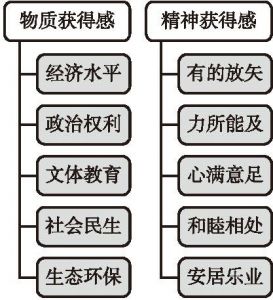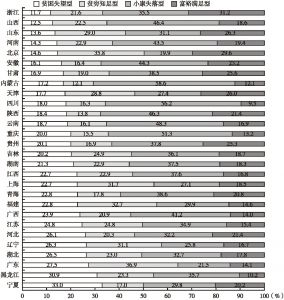摘要
本文对“获得感”这一兼具文化共通性与特殊性的概念进行了学术解读。通过对时代背景、现有理论和实证研究的系统回顾,本文构建了“物质层面(经济水平、政治权利、文体教育、社会民生和生态环保)多重获得”与“精神层面(有的放矢、力所能及、心满意足、和睦相处和安居乐业)多维满足”的获得感测量框架。在此基础上,本文进一步利用2015年中国综合社会调查数据构建指数。结果显示,性别、年龄、受教育水平和城乡差异都会影响国民获得感。参与调查的居民可以按照其获得感特征被分为四类,分别是贫困失望型、贫穷知足型、小康失落型和富裕满足型。获得感测量框架有国别性,更有国际性,未来应进一步巩固其测量学支撑,采取文化本位和文化客位相结合的方法扩展现有研究。
- 曹现强、李烁,2017,《获得感的时代内涵与国外经验借鉴》,《人民论坛·学术前沿》第2期。
- 陈海玉、郭学静、刘庚常,2018,《基于结构方程模型的劳动者主观获得感研究》,《西北人口》第6期。
- 冯帅帅、罗教讲,2018,《中国国民获得感影响因素研究——基于经济激励、国家供给与个体特质的视角》,《贵州师范大学学报》(社会科学版)第3期。
- 郭星华,2001,《城市居民相对剥夺感的实证研究》,《中国人民大学学报》第3期。
- 黄冬霞、吴满意,2017,《思想政治教育获得感:内涵、构成和形成机理》,《思想教育研究》第6期。
- 黄艳敏、张文娟、赵娟霞,2017,《实际获得、公平认知与国民获得感》,《现代经济探讨》第11期。
- 李丹、杨璐、何泽川,2018,《精准扶贫背景下西南民族地区贫困人口获得感调查研究》,《四川大学学报》(哲学社会科学版)第3期。
- 李丹、张苗苗,2018,《西南民族地区贫困人口获得感从何而来》,《财经问题研究》第11期。
- 李婷,2018,《哪一代人更幸福?——年龄、时期和队列分析视角下中国居民主观幸福感的变迁》,《人口与经济》第1期。
- 李晓林、胡会平,2018,《从马克思的正义观看“获得感”》,《山西高等学校社会科学学报》第4期。
- 李原,2017,《不同目标追求对幸福感的影响》,《青年研究》第6期。
- 吕小康、黄妍,2018,《如何测量“获得感”?——以中国社会状况综合调查(CSS)数据为例》,《西北师大学报》(社会科学版)第5期。
- 彭怡、陈红,2010,《基于整合视角的幸福感内涵研析与重构》,《心理科学进展》第7期。
- 曲星,2013,《人类命运共同体的价值观基础》,《求是》第4期。
- 石超、乔晓春,2017,《中国人生活满意度的年龄-时期-队列效应分析》,《人口与发展》第4期。
- 谭旭运、张若玉、董洪杰、王俊秀,2018,《青年人获得感现状及其影响因素》,《中国青年研究》第10期。
- 王慧慧,2014,《民生因素与城乡居民幸福感——基于CGSS数据的实证分析》,《中南财经政法大学学报》第5期。
- 王俊秀,2017,《居民需求满足与社会预期》,《江苏社会科学》第1期。
- 王思斌,2018,《获得感结构及贫弱群体获得感的优先满足》,《中国社会工作》第13期。
- 王恬、谭远发、付晓珊,2018,《我国国民获得感的测量及其影响因素》,《财经科学》第9期。
- 文宏、刘志鹏,2018,《国民获得感的时序比较——基于中国城乡社会治理数据的实证分析》,《社会科学》第3期。
- 习近平,2017,《决胜全面建成小康社会 夺取新时代中国特色社会主义伟大胜利——在中国共产党第十九次全国代表大会上的报告》,新华网(http://www.xinhuanet.com/2017-10/27/c_1121867529.htm)10月27日。
- 邢占军、牛千,2017,《获得感:供需视阈下共享发展的新标杆》,《理论导刊》第5期。
- 阳义南,2018,《民生公共服务的国民“获得感”:测量与解析——基于MIMIC模型的经验证据》,《公共行政评论》第5期。
- 叶胥、谢迟、毛中根,2018,《中国居民民生获得感与民生满意度:测度及差异分析》,《数量经济技术经济研究》第10期。
- 《咬文嚼字》编辑部,2015,《〈咬文嚼字〉编辑部2015年十大流行语》,中国社会科学网(http://www.cssn.cn/yyx/yyx_tpxw/201512/t20151216_2783970.shtml),12月16日。
- 曾维伦,2017,《“将改革进行到底”笔谈之五 切实增强人民的获得感》,《重庆社会科学》第8期。
- 张品,2016,《“获得感”的理论内涵及当代价值》,《河南理工大学学报》(社会科学版)第4期。
- 张彦、魏钦恭、李汉林,2015,《发展过程中的社会景气与社会信心——概念、量表与指数构建》,《中国社会科学》第4期。
- 赵卫华,2018,《消费视角下城乡国民获得感研究》,《北京工业大学学报》(社会科学版)第4期。
- 郑风田、陈思宇,2017,《获得感是社会发展最优衡量标准——兼评其与幸福感、包容性发展的区别与联系》,《人民论坛·学术前沿》第2期。
- 朱斌、苗大雷、李路路,2018,《网络媒介与主观公平感:悖论及解释》,《中国人民大学学报》第32期。
- Andrews,F.M. and S.B. Withey. 1976. . New York: Plenum.
- Berry,J. W. 1989. “Imposed Etics-Emics-Derived Etics: The Operationalization of a Compelling Idea.” 24(6):721-735.
- Bradburn,N.M.1969. . Chicago: Aldine.
- Church,A. Timothy and Marcia S. Katigbak. 1988. “The Emic Strategy in the Identification and Assessment of Personality Dimensions in a Non-Western Culture.” 19(2):140-163.
- Coffey,John K.,Laura Wray-Lake,Debra Mashek and Brittany Branand. 2016. “A Multi-Study Examination of Well-Being Theory in College and Community Samples.” 17(1):187-211.
- Corral,I. and H. Landrine. 2009. “Methodological and Statistical Strategies in Research with Diverse Samples.The Problem of Measurement Equivalence.” pp. 83-134 in New York: Springer.
- Deci,Edward L. and Richard M. Ryan. 2002. ,New York: University of Rochester Press.
- Easterlin,Richard A. 1974. “Does Economic Growth Improve the Human Lot? Some Empirical Evidence.” pp. 89-125 in ,edited by P. A. David and M. W. Reder: Academic Press.
- Gander,Fabian,René T. Proyer and Willibald Ruch. 2017. “The Subjective Assessment of Accomplishment and Positive Relationships: Initial Validation and Correlative and Experimental Evidence for Their Association with Well-Being.” 18(3):743-764.
- Hagerty,Michael R. and Kenneth C. Land. 2007. “Constructing Summary Indices of Quality of Life: A Model for the Effect of Heterogeneous Importance Weights.” 35(4):455-496.
- Helfrich,H. 1999. “Beyond the Dilemma of Cross-cultural Psychology: Resolving the Tension between Etic and Emic Approaches. ”5(2): 131-153.
- Hofstede,G. 1980. Beverly Hills: Sage.
- Hui,C. Harry and Harry C. Triandis. 1985. “Measurement in Cross-Cultural Psychology:A Review and Comparison of Strategies.” 16(2):131-152.
- Jørgensen,Ingvild S. and Hilde Eileen Nafstad. 2012. “Positive Psychology: Historical,Philosophical,and Epistemological Perspectives.” in ,edited by P. A. Linley and S. Joseph.
- Keyes,Corey Lee M. 1998. “Social Well-Being.” 61(2):121-140.
- Keyes,Corey Lee M. and Adam D. Shapiro. 2004. “Social Well-Being in the United States: A Descriptive Epidemiology.” pp. 350-372 in , Chicago,IL,US: University of Chicago Press.
- Lu,Luo and Robin Gilmour. 2004. “Culture and Conceptions of Happiness: Individual Oriented and Social Oriented Swb.” 5(3):269-291.
- Matsumoto,D. and S. Yoo. 2007. “Methodological Considerations in the Study of Emotion across Cultures.” pp. 332-348 in . New York: Oxford University Press.
- Reis,Harry T. and Shelly L. Gable. 2003. “Toward a Positive Psychology of Relationships.” pp. 129-159 in Washington,DC,US: American Psychological Association.
- Ryan,R. M. and Edward L. Deci. 2001. “On Happiness and Human Potentials: A Review of Research on Hedonic and Eudaimonic Well-Being.” 52(1):141-166.
- Ryff,Carol D. 1989a. “Happiness Is Everything,or Is It? Explorations on the Meaning of Psychological Well-Being.” 57(6):1069-1081.
- Ryff,Carol D. 1989b. “Beyond Ponce De Leon and Life Satisfaction: New Directions in Quest of Successful Ageing.” 12(1):35-55.
- Ryff,Carol D. and Burton H. Singer. 2008. “Know Thyself and Become What You Are: A Eudaimonic Approach to Psychological Well-Being.” 9(1):13-39.
- Ryff,Carol D. and Corey Lee M. Keyes. 1995. “The Structure of Psychological Well-Being Revisited.” 69(4):719-727.
- Sasaki,Joni Y.,Deborah Ko and Heejung S. Kim. 2. 14. “Culture and Self-Worth: Implications for Social Comparison Processes and Coping with Threats to Self-Worth.” pp. 230-252 in ,edited by Z. Križan and F. X. Gibbons: Cambridge University Press.
- Seligman,M. E. P. 2011. . New York,NY: Free Press.
- Shu,Xiaoling and Yifei Zhu. 2009. “The Quality of Life in China.” 92(2):191-225.
- Song,Lijun. 2015. “Does Who You Know in the Positional Hierarchy Protect or Hurt? Social Capital,Comparative Reference Group,and Depression in Two Societies.” 136-137:117-127.
- Van Landeghem,Bert. 2012. “A Test for the Convexity of Human Well-Being over the Life Cycle: Longitudinal Evidence from a 20-Year Panel.” 81(2):571-582.
- Walker,Iain and Heather J. Smith. 2002. ,Edited by I. Walker and H. J. Smith. New York: Cambridge University Press.
- Waterman,Alan S. 1993. “Two Conceptions of Happiness: Contrasts of Personal Expressiveness (Eudaimonia) and Hedonic Enjoyment.” 64(4): 678-691.







